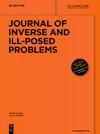Correctness and regularization of stochastic problems
IF 0.9
4区 数学
Q2 MATHEMATICS
引用次数: 0
Abstract
Abstract The paper is devoted to the regularization of ill-posed stochastic Cauchy problems in Hilbert spaces: (0.1)随机问题的正确性和正则化
研究Hilbert空间中不适定随机柯西问题的正则化问题:(0.1)d²u²(t) = A²u²(t)²d²(t) + B²W²(t), t >0 u²(0)= ξ。du(t)=Au(t)dt+BdW(t), \quadt>0\qquad, u(0)= \xi。正则化的需要与以下事实有关:在一般情况下,算子A不应生成强连续半群,并与定义无限维维纳过程{W¹(t):t≥0 }{W(t):t{\geq 0}的级数的散度有关}。正则算子的构造利用了Dunford-Schwartz算子、正则半群、广义傅里叶变换和无穷维Q -Wiener过程等技术。
本文章由计算机程序翻译,如有差异,请以英文原文为准。
求助全文
约1分钟内获得全文
求助全文
来源期刊

Journal of Inverse and Ill-Posed Problems
MATHEMATICS, APPLIED-MATHEMATICS
CiteScore
2.60
自引率
9.10%
发文量
48
审稿时长
>12 weeks
期刊介绍:
This journal aims to present original articles on the theory, numerics and applications of inverse and ill-posed problems. These inverse and ill-posed problems arise in mathematical physics and mathematical analysis, geophysics, acoustics, electrodynamics, tomography, medicine, ecology, financial mathematics etc. Articles on the construction and justification of new numerical algorithms of inverse problem solutions are also published.
Issues of the Journal of Inverse and Ill-Posed Problems contain high quality papers which have an innovative approach and topical interest.
The following topics are covered:
Inverse problems
existence and uniqueness theorems
stability estimates
optimization and identification problems
numerical methods
Ill-posed problems
regularization theory
operator equations
integral geometry
Applications
inverse problems in geophysics, electrodynamics and acoustics
inverse problems in ecology
inverse and ill-posed problems in medicine
mathematical problems of tomography
 求助内容:
求助内容: 应助结果提醒方式:
应助结果提醒方式:


